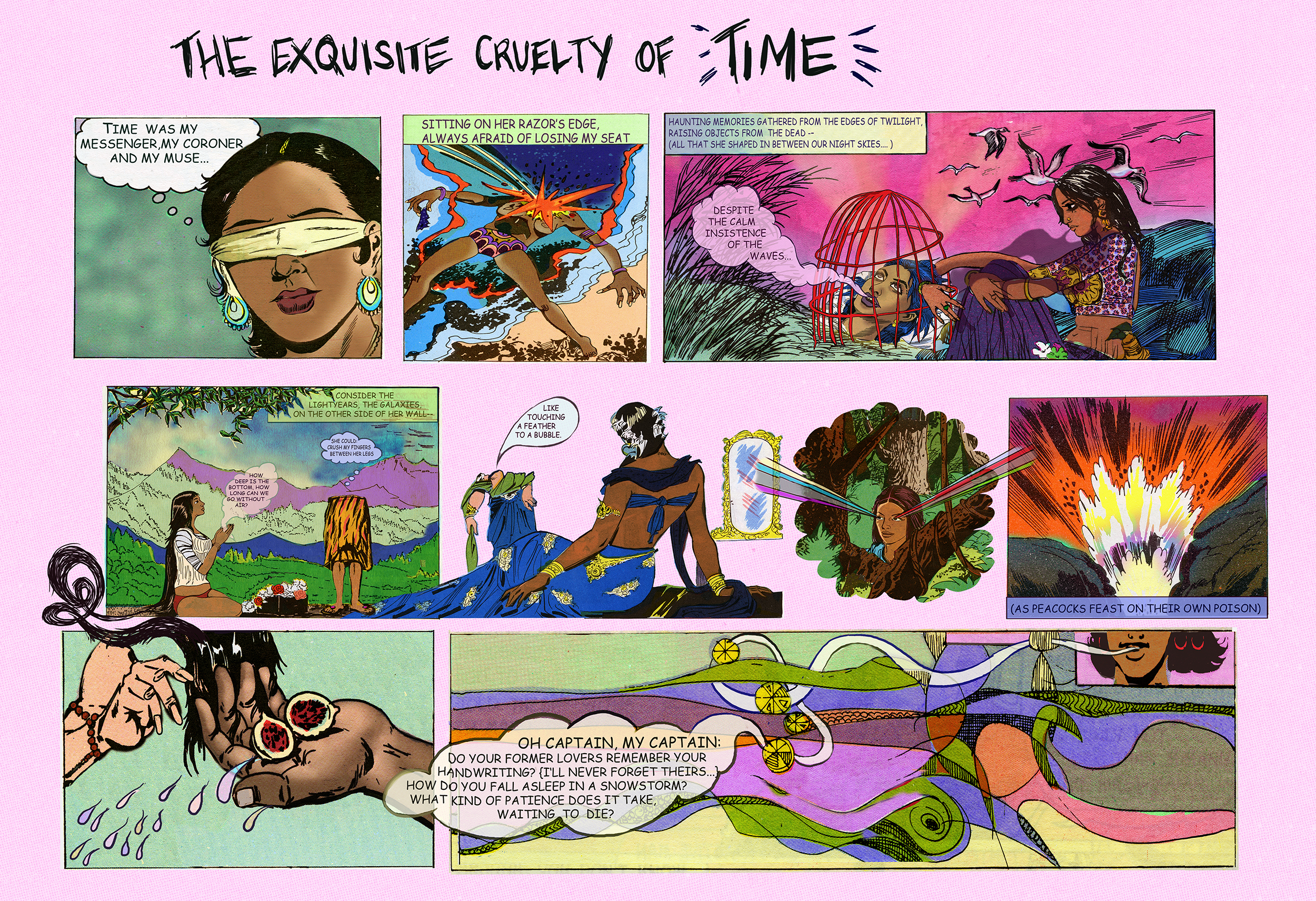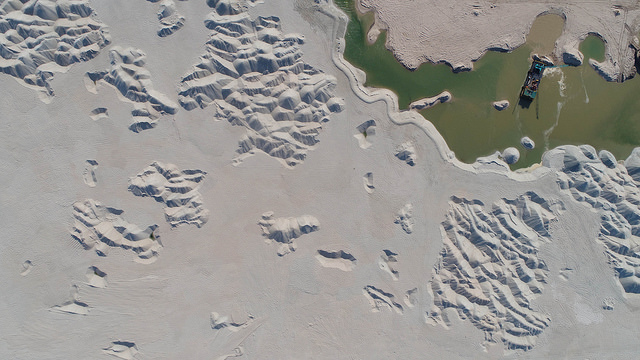The groundbreaking art and visual vocabulary of Chitra Ganesh

December 21, 2022
I remember going into Chitra’s studio, which was in the living room of her apartment in Prospect Heights, Brooklyn, over twenty years ago. We lived a block apart, and I was often in her studio, talking and listening to music. I would photoshop images on my laptop, while she stretched and painted large canvases, and we would talk, laugh, and dream aloud.
When I first saw what would become her 2001 installation about her mother’s death, How I Found Her, my heart leapt. The final installation showed a very simple shelf with metal brackets from a hardware store. On top of it were Band-Aids, bottles of hydrogen peroxide, and well-worn red-rimmed glasses. Above the shelf, a series of Polaroids depicted the bathroom where the artist had found her mother; one staged photo even showed the artist lying down on the tiled bathroom floor. Beneath the shelf, a towel rack with a sari blouse and an orange-and-green silk sari. Not just any sari, but the remains of the sari the artist’s mother was wearing the day she died.

In an artist statement on the piece, Chitra writes:
How I Found Her uses the altar, popular vernacular form of social expressions and mythic hybridity, to investigate and develop another personal mythology: that of my mother, the story of her death, and (after) life. I locate myself in the place of her corpse, meditate upon her haunting by arranging household refuse into geometrical forms. My work talks about transformation that is both social and personal, which collides head-on with a comfort in alienation and the facts of self-inflicted violence.
When you have long friendships, you know each other through a series of celebrations and losses, moments of joy and of mourning. I regretfully never met Chitra’s mother, as we were becoming friends around the time that her mother had passed away. The loss was especially devastating because her mother was so young, and we were even younger, just starting our young adult lives. But I felt her mother’s presence in that installation, being among her things.

Artists often use these moments of loss as our material, but until I encountered How I Found Her, I had never personally known an artist who used actual artifacts that represented grief and loss. The objects were so emotionally and narratively charged. She asked, and I believe answered, questions such as: What do we do with our loss, our grief, our sadness, our mourning? What can we do when we can’t simply move on that quickly? What can we create with what remains?
This work gave me permission to mine my own deepest grief and sadness, and use the actual artifacts from these moments in my artwork. For example—while knowing it is certainly not the same thing at all—the end of my marriage was the single biggest grief I experienced in my twenties. For years, I made artwork that referenced this loss, much of which was the loss of a former self and an imagined future. I ended up using the remains of this failed love in an installation using my own wedding sari, engagement ring, and mangalsutra, a necklace often worn in Punjabi Sikh and Hindu wedding rituals.
Artists never forget an artist who gives us permission to make the art we are finally brave enough to make. Chitra’s installation inspired decades of my own work and even the seeds of Remains, a notebook of fourteen flash fiction stories published this month in The Margins, which explores similar questions of loss and the afterlife. Details from two of Chitra’s pieces, Anima Mundi (commissioned by Creative Time Comics in 2020) and The Exquisite Cruelty of Time (commissioned by The Kitchen in 2020), accompany the pieces in the notebook. As with How I Found Her, in these two pieces we see the artist’s exploration of eternal themes—grief, longing, memory, mythology, and the way women and feminine bodies mark space and time.
I was thrilled when Chitra agreed to feature her work in this notebook and be in conversation with these Asian diasporic literary voices. She has a long history with the Asian American Writers’ Workshop, including teaching the workshop “Empowering Girls Through Comics,” having her work illustrate a poem in The Margins, and speaking on the legacy of Amar Chitra Katha comic books—one of many visual vocabularies her work references and transforms. The two of us even met at the former St. Mark’s location of the Asian American Writers’ Workshop during a South Asian Women’s Creative Collective (SAWCC) meeting, which she also describes as a pivotal space. Founded by Jaishri Abichandani, SAWCC became the environment where so many lifelong friendships were formed. I have been delighted to work with Chitra on many SAWCC projects, and bear witness to her development as an artist, especially after having seen the seedlings of it.
I hope if you had not encountered Chitra Ganesh’s work before this flash fiction notebook, you can dig in further and bear witness to one of today’s most groundbreaking and significant Asian American artists. And if you have seen her work before and often, I hope you’ll enjoy being in its company again, in a new context that pairs its incredible emotional rigor and textual complexity with those of the stories from the notebook.
More about Chitra Ganesh:
Chitra Ganesh (b. 1975 Brooklyn, New York, USA) received a BA in Art-Semiotics and Comparative Literature from Brown University, Providence, RI in 1996. She attended the Skowhegan School of Painting and Sculpture in 2001 and received her MFA in Visual Arts from Columbia University, NY in 2002. She lives and works in Brooklyn, NY, USA.
Across a twenty-year practice, Chitra Ganesh has developed an expansive body of work rooted in drawing and painting, which has evolved to encompass animations, wall drawings, collages, computer generated imagery, video, and sculpture. Through studies in literature, semiotics, social theory, science fiction, and historical and mythic texts, Ganesh attempts to reconcile representations of femininity, sexuality, and power absent from the artistic and literary canons. She often draws on Hindu and Buddhist iconography and South Asian forms such as Kalighat and Madhubani, and is currently negotiating her relationship to these images with the rise of right wing fundamentalism in India.
Ganesh’s work has been widely exhibited in the United States and internationally, including solo shows at Brooklyn Museum, NY,USA; MoMA PS1, NY, USA; The Kitchen, NY, USA; The Rubin Museum of Art, NY, USA; The Andy Warhol Museum, PA, USA; Gothenburg Kunsthalle, Sweden; and Times Square, NY,USA. Her work has also been exhibited in important group exhibitions at The Walker Art Center, MN, USA; the Baltimore Museum of Art, MD, USA; The Queens Museum of Art, NY, USA; The Asia Society, NY, USA; The Bronx Museum, NY, USA; The Contemporary Arts Museum, Houston, TX, USA; the Berkeley Art Museum and Pacific Film Archive, CA, USA; the Museum of Contemporary Art San Diego, CA, USA; the Boca Raton Museum of Art, LA, USA; the Hayward Gallery, London, UK; Saatchi Museum, London, UK: Fondazione Sandretto Re Rebaudengo, Italy; Instituto Valenciano de Arte Moderno, Italy; the ZKM Center for Art and Media, Germany; Göteborgs Konsthall, Germany; Arthotek Kunstverein, Göttingen, Germany; the Museum of Contemporary Art, Shanghai, China; the Gwangju Contemporary Arts Centre, Korea; the Prince of Wales Museum, Mumbai, India; Indira Ghandi National Centre for Arts, New Delhi, India; Devi Art Foundation, India; the Kochi Biennial, India; the Dhaka Art Summit, Bangladesh among others.
Ganesh’s work is represented in the collections of the Museum of Modern Art, NY, USA; San Francisco Museum of Modern Art, CA, USA; the Whitney Museum of American Art, NY, USA; The Brooklyn Museum, NY, USA; The Art Institute of Chicago, IL, USA; Smithsonian American Art Museum, Washington, DC; The Ford Foundation, NY, USA; University of Michigan Museum of Art, MI, USA; The Pennsylvania Academy of Fine Arts, PA, USA; the Devi Art Foundation, India; Kiran Nadar Museum, Delhi, India; the Saatchi Collection, London, UK; Burger Collection, Hong Kong; Deutsche Bank, among others.
Ganesh is the recipient of numerous fellowships and awards, including grants from the New York Foundation for the Arts; Printed Matter; the Art Matters Foundation; the John Simon Guggenheim Memorial Foundation Fellowship in the Creative Arts; the Joan Mitchell Foundation Award for Painters and Sculptors; and the Hodder Fellowship from the Lewis Center for the Arts at Princeton University, and the Pollock Krasner Foundation.
This piece is part of the Remains notebook, which features art by Chitra Ganesh.



